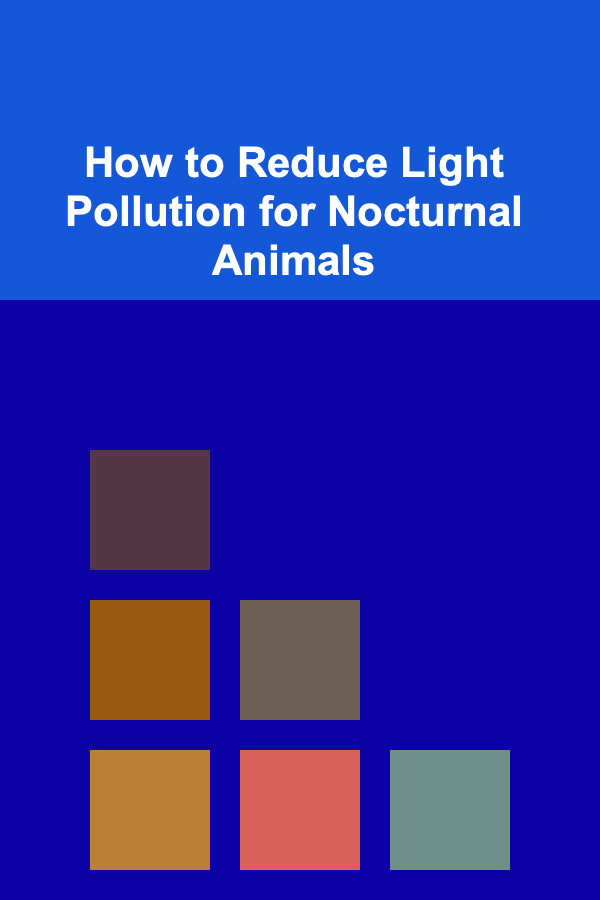
How to Reduce Light Pollution for Nocturnal Animals
ebook include PDF & Audio bundle (Micro Guide)
$12.99$6.99
Limited Time Offer! Order within the next:

Light pollution is a growing environmental issue that is often overlooked by many. While it affects human health and safety, the impact on wildlife, especially nocturnal animals, is much more profound. These creatures have evolved to thrive in dark environments, and artificial lighting disrupts their natural behaviors, such as foraging, mating, and migration. In this article, we will explore the various effects of light pollution on nocturnal animals, the importance of mitigating these impacts, and practical steps that can be taken to reduce light pollution in a way that benefits both human society and wildlife.
Understanding Light Pollution
Light pollution refers to the excessive or misdirected artificial light that interferes with the natural environment. It is a widespread phenomenon, especially in urban areas, where streetlights, buildings, and other human activities emit light that spills into the night sky. There are different types of light pollution, including:
- Skyglow: The brightening of the night sky over populated areas.
- Glare: Intense, blinding light that reduces visibility.
- Light Trespass: Light that spills over into areas where it is not needed or wanted.
- Clutter: Bright, excessive lighting in areas such as city centers, which confuses both humans and animals.
For nocturnal animals, the disruption caused by these types of light pollution can be far-reaching. Animals that depend on darkness for their survival are highly sensitive to light. Their behaviors and survival strategies, honed over millennia, are no longer functioning as intended due to the overwhelming presence of artificial light.
The Impact of Light Pollution on Nocturnal Animals
Nocturnal animals, such as bats, moths, frogs, and many bird species, have developed highly specialized behaviors that allow them to function in the dark. Light pollution interferes with these natural processes in a number of ways:
1. Disruption of Feeding Patterns
Many nocturnal animals rely on darkness to hunt and forage. For example, moths are attracted to light sources, which in many cases causes them to fly toward artificial lights, away from their natural foraging grounds. This not only reduces their chances of finding food but can also put them in harm's way, where predators may take advantage of their distracted state.
Bats, which use echolocation to detect prey, are also affected by light pollution. Their hunting efficiency can be significantly reduced when artificial lighting interferes with their ability to navigate or detect their prey. This results in a lower success rate for foraging, which affects their overall survival.
2. Mating and Reproduction Interference
Artificial light affects the mating behaviors of many nocturnal species. For example, some species of fireflies use bioluminescent flashes as part of their mating ritual. Light pollution can obscure these signals, making it difficult for mates to find each other. This disruption can lead to a decrease in reproductive success, threatening the survival of these species.
Similarly, many bird species rely on the darkness of night to find suitable nesting areas or to mate. The intrusion of light into their natural habitats confuses these species, and in some cases, it can lead to early or delayed hatching or even the abandonment of nests altogether.
3. Disorientation and Migration Disruption
Many species of birds, particularly migratory species, rely on natural light cues such as the moon and stars to navigate. Artificial lighting, especially in coastal or urban areas, can confuse these birds during migration. This disorientation can lead to birds becoming lost, flying into buildings or power lines, or failing to find suitable resting spots. In some cases, entire populations of migratory birds have been seen circling bright lights in confusion, causing exhaustion and death.
Sea turtles, which hatch on the beaches and make their way to the ocean, are another species greatly affected by light pollution. Hatchlings are naturally drawn to the brightness of the ocean, but when artificial lights from nearby buildings or street lamps are present, they may head in the wrong direction, often toward roads or urban areas, rather than toward the sea. This increases their chances of being killed by vehicles or becoming stranded.
4. Disturbance to Sleep Cycles and Predation
Light pollution can also interfere with the circadian rhythms of nocturnal animals, disrupting their sleep cycles and overall health. Just as artificial light affects human sleep patterns, it can have similar effects on animals. A disruption in their natural sleep patterns can lead to chronic stress and weakened immune systems, making them more vulnerable to diseases and predation.
Some predators, such as owls and other night-hunting birds of prey, rely on the cover of darkness to hunt efficiently. If their natural environment is lit up, it can make it harder for them to stalk their prey or hunt effectively, reducing their ability to feed. On the flip side, prey animals may be forced to stay hidden during times when they would typically forage, leading to starvation or injury.
5. Impact on Ecosystem Dynamics
The cascading effects of light pollution on nocturnal species can reverberate throughout entire ecosystems. If one species is impacted, it can throw off the balance of the ecosystem. For example, if a certain species of insect is drawn to artificial light, its predators may follow suit, leading to an imbalance in the predator-prey relationship. This can cause a decline in the populations of other species that rely on the same prey, creating a ripple effect throughout the food chain.
Why Reducing Light Pollution is Critical
The impact of light pollution on nocturnal animals is profound, but reducing light pollution benefits not only wildlife but also human society. As we learn more about the ecological consequences of artificial light, it becomes increasingly clear that sustainable lighting practices are essential for maintaining biodiversity, ecosystem health, and even human well-being.
- Preserving Biodiversity: By protecting nocturnal species from the harmful effects of light pollution, we can ensure that they continue to thrive. Many of these animals play key roles in maintaining ecosystems, such as controlling pest populations and pollinating plants. If these species decline or become extinct, it could lead to a breakdown in ecosystem functions.
- Improving Human Health: Light pollution doesn't just affect animals; it also has significant consequences for human health. The disruption of circadian rhythms in both humans and animals has been linked to sleep disorders, stress, and other health issues. Reducing artificial light exposure, especially at night, can help mitigate these health risks.
- Enhancing the Night Sky: Light pollution obscures our view of the night sky, preventing people from enjoying the beauty of stars, planets, and celestial events. By reducing unnecessary light, we can reconnect with the natural world and restore the wonders of the night sky.
Steps to Reduce Light Pollution
While light pollution is a pervasive issue, there are several measures that can be taken to reduce its impact on nocturnal animals and the environment. Here are some effective strategies for mitigating light pollution:
1. Implementing Shielded Lighting
One of the most effective ways to reduce light pollution is to use shielded lighting. Shielded lights direct light downward, preventing it from spilling into the sky and surrounding areas. This helps to minimize the impact on nocturnal animals, who rely on darkness for survival. In urban areas, this can be accomplished by replacing streetlights with downward-facing, shielded models that provide sufficient illumination without causing unnecessary light spill.
2. Using Motion-Sensitive Lighting
Motion-sensitive lighting is an energy-efficient solution that reduces unnecessary lighting during the night. These lights turn on only when they detect movement, ensuring that they are only active when needed. This can help reduce light pollution, particularly in areas where human activity is minimal during the night. Motion-sensing lights can be installed in both residential and commercial settings, and they can be a valuable tool in minimizing disruption to wildlife.
3. Adopting LED Lighting
LED lights are more energy-efficient than traditional lighting, and they can be used to minimize light pollution. Many LED lights are available in specific color temperatures that are less disruptive to wildlife. For example, warm white LEDs emit less blue light, which is known to have a more significant impact on nocturnal animals. By replacing bright, harsh lighting with warmer, low-intensity LEDs, we can reduce light pollution while maintaining safety and visibility.
4. Educating the Public
Public education and awareness are essential in the fight against light pollution. Many people are unaware of the negative effects that artificial lighting has on wildlife and the environment. By informing the public about the importance of reducing light pollution, communities can take collective action to reduce unnecessary lighting and adopt more sustainable practices. This could include encouraging people to turn off lights when they are not needed, using outdoor lighting only when necessary, and installing energy-efficient lighting in their homes and businesses.
5. Designating Dark Zones
Some areas have designated "dark zones" where artificial lighting is minimized or completely restricted. These zones are established to protect natural habitats and provide a sanctuary for nocturnal species. By creating more dark zones and encouraging the protection of natural nightscapes, we can create safe havens for wildlife and reduce the spread of light pollution.
6. Enforcing Regulations
Governments and local authorities can play a crucial role in reducing light pollution by enacting and enforcing lighting regulations. These regulations can mandate the use of energy-efficient, shielded lighting in public spaces, as well as restrict the use of bright, unnecessary lighting during certain hours. By taking a proactive approach to managing artificial light, governments can significantly reduce the negative impact of light pollution on nocturnal animals and ecosystems.
Conclusion
Light pollution is an urgent environmental issue that threatens the survival of nocturnal animals and disrupts the natural balance of ecosystems. The effects of artificial light on wildlife are widespread, from interference with feeding patterns to disruption of mating behaviors and migration routes. However, by implementing practical solutions such as shielded lighting, motion-sensing systems, and public education, we can make a significant impact in reducing light pollution.
It is not just the responsibility of governments or organizations to address this issue; every individual can make a difference by adopting more sustainable lighting practices. In doing so, we will not only protect nocturnal animals but also enhance the quality of life for all living beings on this planet, including ourselves. The preservation of natural darkness is a vital step toward maintaining biodiversity, improving human health, and ensuring a sustainable future for generations to come.

10 Proven Tips for Saving on Group Tours and Travel Packages
Read More
How to Invest in Real Estate with Little Money
Read More
How to Prepare for Your Honeymoon After the Wedding: An Actionable Guide
Read More
Integrating Exercise into a Busy Schedule: A Comprehensive Guide
Read More
How to Conquer Disney World with Toddlers: A 10-Step Checklist
Read More
10 Tips for Keeping Your Fish Stress-Free
Read MoreOther Products

10 Proven Tips for Saving on Group Tours and Travel Packages
Read More
How to Invest in Real Estate with Little Money
Read More
How to Prepare for Your Honeymoon After the Wedding: An Actionable Guide
Read More
Integrating Exercise into a Busy Schedule: A Comprehensive Guide
Read More
How to Conquer Disney World with Toddlers: A 10-Step Checklist
Read More